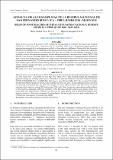Por favor, use este identificador para citar o enlazar este ítem:
https://hdl.handle.net/20.500.12958/3612Registro completo de metadatos
| Campo DC | Valor | Lengua/Idioma |
|---|---|---|
| dc.contributor.author | Meza Torres, María Andrea | - |
| dc.contributor.author | Llapapasca Lloclla, Miguel | - |
| dc.contributor.author | Romero, Cynthia | - |
| dc.date.accessioned | 2021-10-20T01:11:45Z | - |
| dc.date.available | 2021-10-20T01:11:45Z | - |
| dc.date.issued | 2021-07 | - |
| dc.identifier.citation | Meza M A, Llapapasca M, Romero C. 2021. Avifauna de algunas playas de la Reserva Nacional de San Fernando (RNSF) Ica – Perú. Junio 2018 – mayo 2019. Bol Inst Mar Perú. 36(1): 29-43 | es_ES |
| dc.identifier.issn | 04587766 | - |
| dc.identifier.uri | https://hdl.handle.net/20.500.12958/3612 | - |
| dc.description.abstract | El presente trabajo detalla la información mensual de la avifauna que se realizó en doce playas de la Reserva Nacional de San Fernando (RNSF) (UTM 500944,50 m S, 1643478,24 m O) de junio 2018 a mayo 2019. A lo largo del año de evaluación se registró 19 familias divididas en 29 especies de aves, de las cuales 24 corresponden al grupo de aves marinas y cinco a los ambientes terrestres; las más abundantes fueron Larosterna inca (Lesson, 1827) (18,68 ind./m) y Sula variegata (Tschudi, 1843)(5,24 ind./m). La llegada de ciertas aves migratorias entre primavera 2018 y otoño 2019 podría tener efecto en la composición y abundancia de especies en las playas evaluadas, existiendo alta similaridad (73%) en las estaciones de verano – otoño y primavera - invierno. Finalmente, se debe resaltar que se observó evidencias reproductivas de algunas especies como: pingüino de Humboldt, chuita, cushuri, piquero peruano, gaviota peruana, zarcillo y el aguilucho variable, especies residentes registradas en la RNSF. | es_ES |
| dc.description.abstract | ABSTRACT: This research details the information gathered during the monthly observation of birdlife in 12 beaches of the San Fernando National Reserve (SFNR) (UTM 500944.50m S, 1643478.24m W) between June 2018 and May 2019. We recorded 19 families divided into 29 bird species, of which 24 are seabirds and 5 live on land. The most abundant were Larosterna inca (Lesson, 1827) (18.68 ind, /m) and Sula variegata (Tschudi, 1843)(5.24 ind. /m). The arrival of certain migratory birds between spring 2018 and autumn 2019 could affect the species composition and abundance on the beaches evaluated, with high similarity (73%) between summer-autumn and spring-winter. It is noteworthy that reproductive evidence was observed for some species such as Humboldt penguin, red-legged cormorant, Neotropic cormorant, Peruvian booby, Belcher ́s gull, Inca tern, and variable hawk, all of which are local species recorded in the SFNR. | - |
| dc.language.iso | spa | es_ES |
| dc.publisher | INSTITUTO DEL MAR DEL PERÚ | es_ES |
| dc.relation.ispartofseries | Boletín IMARPE 36(1), 2021; | - |
| dc.rights | info:eu-repo/semantics/openAccess | es_ES |
| dc.rights.uri | https://creativecommons.org/licenses/by/4.0/ | es_ES |
| dc.source | Instituto del Mar del Perú - IMARPE | es_ES |
| dc.source.uri | Repositorio Digital IMARPE | es_ES |
| dc.subject | Área natural protegida | es_ES |
| dc.subject | Avifauna | es_ES |
| dc.subject | Biodiversidad | es_ES |
| dc.title | Avifauna de algunas playas de la Reserva Nacional de San Fernando (RNSF) Ica – Perú. Junio 2018 – mayo 2019 | es_ES |
| dc.title.alternative | Birds of some beaches of the San Fernando National Reserve (SFNR) Ica, Peru (June 2018 - May 2019) | es_ES |
| dc.type | info:eu-repo/semantics/article | es_ES |
| dc.publisher.country | Perú - Callao | es_ES |
| dc.subject.ocde | http://purl.org/pe-repo/ocde/ford#1.06.12 | es_ES |
| Aparece en las colecciones: | Boletín 36(1), 2021 | |
Ficheros en este ítem:
| Fichero | Descripción | Tamaño | Formato | |
|---|---|---|---|---|
| Boletin 36-1 articulo2.pdf | 2,39 MB | Adobe PDF |  Visualizar/Abrir |
Este ítem está sujeto a una licencia Creative Commons Licencia Creative Commons

